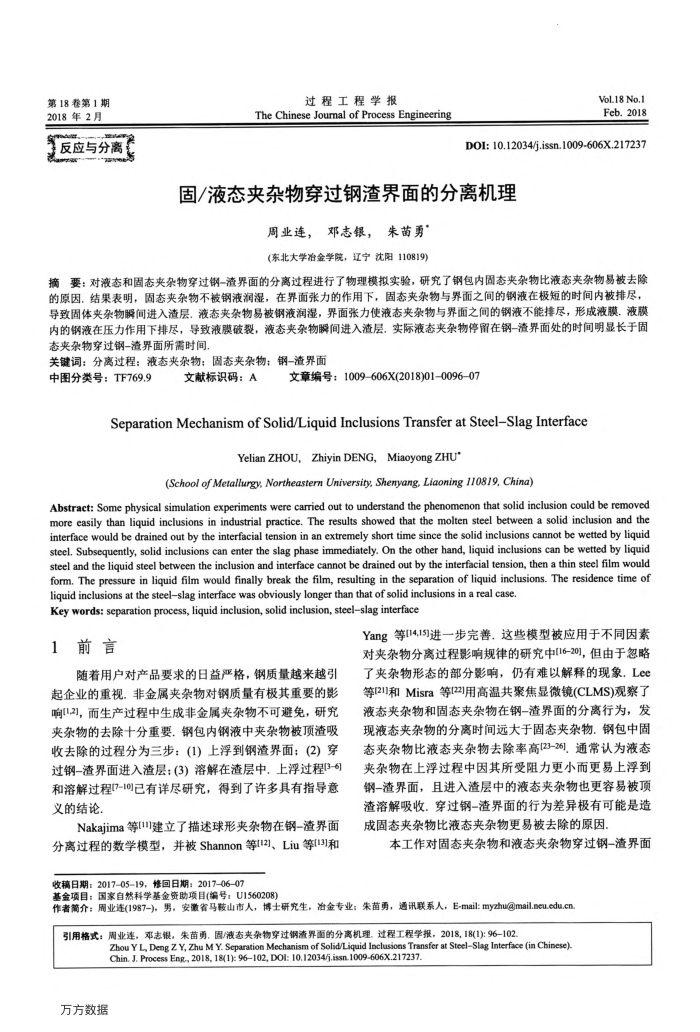您当前的位置:首页>论文资料>固∕液态夹杂物穿过钢渣界面的分离机理
内容简介
 第18卷第1期 2018年2月
第18卷第1期 2018年2月e
反应与分离 ag
过程工程学报
The Chinese Joumal of Process Engineering
VoL.18 No.1 Feb.2018
DOI: 10.12034/j.issn.1009-606X.217237
固/液态夹杂物穿过钢渣界面的分离机理
周业连,邓志银,
朱苗勇”
(东北大学冶金学院,辽宁沈阳110819)
摘要:对液态和固态夹杂物穿过钢-渣界面的分离过程进行了物理模拟实验,研究了钢包内固态夹杂物比液态夹杂物易被去除的原因.结果表明,固态夹杂物不被钢液润湿,在界面张力的作用下,固态夹杂物与界面之间的钢液在极短的时间内被排尽,导致固体夹杂物瞬间进入渣层,液态夹杂物易被钢液润湿,界面张力使液态夹杂物与界面之间的钢液不能排尽,形成液膜液膜内的钢液在压力作用下排尽,导致液膜破裂,液态夹杂物瞬间进入渣层,实际液态夹杂物停留在钢-渣界面处的时间明显长于固态夹杂物穿过钢-渣界面所需时间
关键词:分离过程;液态夹杂物:固态夹杂物;钢-渣界面
中图分类号:TF769.9
文献标识码:A
文章编号:1009-606X(2018)01-009607
Separation Mechanismof Solid/Liquid InclusionsTransferat SteelSlag Interface
Yelian ZHOU, Zhiyin DENG, Miaoyong ZHU"
(School ofMetallurgy,Northeastern University,Shenyang,Liaoning I10819,China)
Abstract: Some physical simulation experiments were carried out to understand the phenomenon that solid inclusion could be removed more easily than liquid inclusions in industrial practice. The results showed that the molten steel between a solid inclusion and the interface would be drained out by the interfacial tension in an extremely short time since the solid inclusions cannot be wetted by liquid steel. Subsequently, solid inclusions can enter the slag phase immediately. On the other hand, liquid inclusions can be wetted by liquid steel and the liquid steel between the inclusion and interface cannot be drained out by the interfacial tension, then a thin steel film would form. The pressure in liquid film would finally break the film, resulting in the separation of liquid inclusions. The residence time of
liquid inclusions at the steelslag interface was obviously longer than that of solid inclusions in a real case. Key words: separation process, liquid inclusion, solid inclusion,steelslag interface
前言 1
随着用户对产品要求的日益严格,钢质量越来越引起企业的重视.非金属夹杂物对钢质量有极其重要的影响[12],而生产过程中生成非金属夹杂物不可避免,研究夹杂物的去除十分重要.钢包内钢液中夹杂物被顶渣吸收去除的过程分为三步:(1)上浮到钢渣界面;(2)穿过钢-渣界面进入渣层:(3)溶解在渣层中,上浮过程(3-6) 和溶解过程17-10]已有详尽研究,得到了许多具有指导意义的结论
Nakajima等(]建立了描述球形夹杂物在钢-渣界面分离过程的数学模型,并被Shannon等(12]、Liu等[13]和收稿日期:2017-0519,修回日期:2017-0607
基金项目:国家自然科学基金资助项目(编号:U1560208)
Yang等1415]进一步完善,这些模型被应用于不同因素对夹杂物分离过程影响规律的研究中[16-20],但由于忽略了夹杂物形态的部分影响,仍有难以解释的现象.Lee 等[21]和Misra等[22]用高温共聚焦显微镜(CLMS)观察了液态夹杂物和固态夹杂物在钢-渣界面的分离行为,发现液态夹杂物的分离时间远大于固态夹杂物。钢包中固态夹杂物比液态夹杂物去除率高(23-26],通常认为液态夹杂物在上浮过程中因其所受阻力更小而更易上浮到钢-渣界面,且进入渣层中的液态夹杂物也更容易被顶渣溶解吸收,穿过钢-渣界面的行为差异极有可能是造成固态夹杂物比液态夹杂物更易被去除的原因,
本工作对固态夹杂物和液态夹杂物穿过钢-渣界面
作者简介:周业连(1987-),男,安徽省马鞍山市人,博士研究生,冶金专业;朱苗勇,通讯联系人,E-mail:myzhu@mail.neu.edu.cn 引用格式:周业连,邓志银,朱苗勇.固/液态夹杂物穿过钢渣界面的分离机理。过程工程学报,2018,18(1):96-102.
Zhou Y L, Deng Z Y, Zhu M Y. Separation Mechanism of Solid/Liquid Inclusions Transfer at SteelSlag Interface (in Chinese) Chin. J. Process Eng, 2018, 18(1): 96102, DOI: 10.12034/jissn.1009-606X.217237
万方数据
上一章:钢渣对废水中磷的吸附性能
下一章:不锈钢钢管轧机电气控制系统研究与应用